Have you ever been out walking, seen a person having a pleasant jaunt with their pooch, and thought, “Wow! Those two are really enjoying their time together!”
Chances are great that the dog was walking along near her owner with no tightness on the leash, and she may have even been checking in by glancing at her person frequently, perhaps with a big doggy smile on her face!
Dogs love to go for walks with their peeps!
Dogs who have been taught how to walk with good leash manners are a fine sight to see. They also tend to have fewer on-leash behavioral issues (such as leash reactivity), and they are able to avoid the body soreness that can come from pulling too much – as can their caretakers.
Leash manners that make walking your dog a joy are no accident, and leash handling skills are one of the things you need to master to make wonderful walks a reality.
This may seem like a fairly insignificant detail, but the way you hold onto your dog’s leash (not to mention the leash you choose) can make a big difference in the quality of your daily walks. Holding a leash correctly can also prevent injury to the person attached to that furry ball of energy.
Read on to learn more about this useful skill and which leash may be best for you and your dog!
How to Hold Your Dog’s Leash: Takeaways
- Holding your leash properly keeps you and your dog safe. A proper grip on the leash allows for better control of your pooch.
- There are three basic grips dog trainers recommend using. We’ll discuss them in detail below, but they are the thumb grip, the finger grip, and the accordion grip. You can use any of the three you like, but be sure to try them all to ensure you find the one that works best for you.
- Make sure you choose a good leash too! Leashes vary in a million ways, so it’s important to know what to look for. This includes considering the leash’s length, the style, and the material it’s made of.
The Proper Way to Hold Your Dog’s Leash: Three Great Options
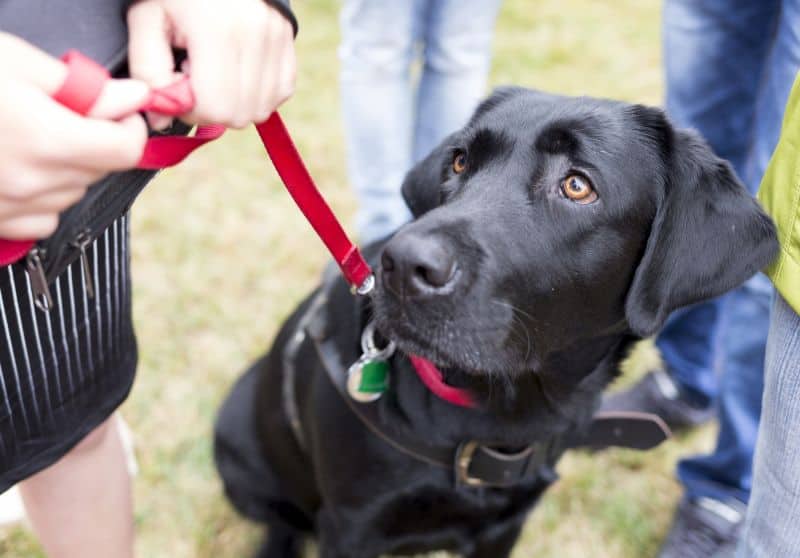
You need to hold your dog’s leash in a way that allows you to grip it securely while still being able to give your dog more or less leash length at a moment’s notice.
Fortunately, there are a few easy ways to hold your dog’s leash that can help give you the control of your canine you need, while simultaneously preventing injuries to you if your dog suddenly pulls hard on her leash.
We’ll discuss three of the best leash-holding grips below.
#1 The Thumb Grip
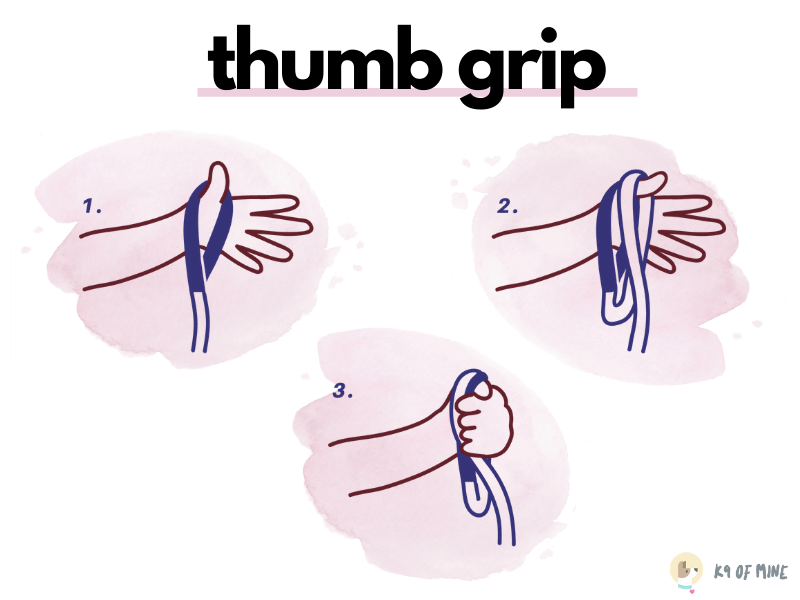
Place your thumb through the loop handle of the leash. Then, gather some of the leash’s slack, and loop it over your thumb again.
Close your fist with all the layers of leash inside it and your thumb across the top, with the remainder of the leash exiting your hand on the pinky side. This is your anchor!
You can adjust how much of the remaining leash length is available for your dog to use with the placement of your second hand. You don’t need to hold the dog close to you, but you do want to pick up enough slack that the dog doesn’t step over the leash accidentally.
Remember, the leash should exit both hands on the pinky side!
If you need to give your dog some more slack, open your anchor hand with your thumb pointing up and release as many loops of slack as you want to. Since the handle of your leash is around your thumb, it will help prevent you from dropping your leash.
If you need to hold on more tightly, hold your leash near your navel with your anchor hand above your other hand, like you’re holding a baseball bat.
Best for: People who like to have their dog walking on the opposite side of their body from their anchor hand. In other words, you may use your left hand to anchor the leash, while having your doggo walk on your right side.
#2 The Finger Grip
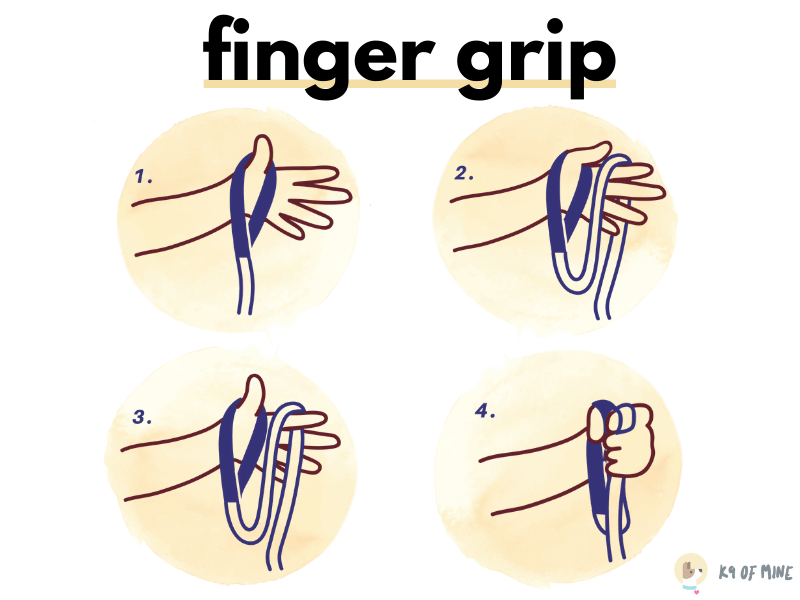
Similar to the thumb grip, the finger grip starts with you placing your thumb through the loop handle of the leash.
Grab some of the slack in your leash and make a loop over the first finger (rather than your thumb) of the same hand. You can make another slack loop too, if you like.
Grip all the leash layers in your fist, with your thumb on top and the leash exiting your hand on the pinky side. This is your anchor!
If you want to give your dog more slack in the leash, open your anchor hand with your thumb up. It is easy to release all the slack at once since the loops are over your finger, and to close your fist around the leash handle to re-establish the anchor.
Best for: People who want to walk their dog on the same side of their body as their anchor hand.
#3 The Accordion Grip
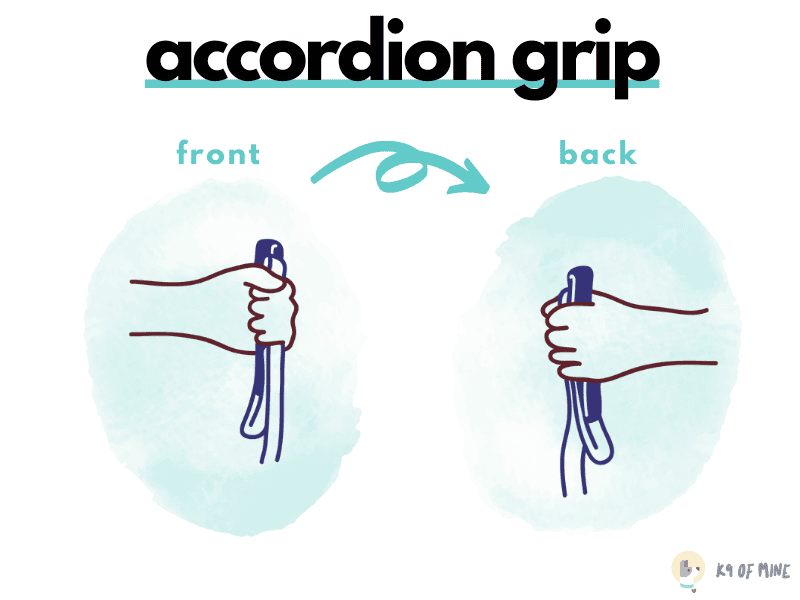
With the accordion grip, the loop of the leash can be placed over the thumb or wrapped around the knuckles of the four fingers, but oftentimes it isn’t wrapped around anything.
The leash is layered back and forth a few times across the palm and gripped in the fist, with the remaining leash length exiting the hand on the pinky side toward the dog. This is your anchor!
The other hand may hold some of the remaining leash slack if the dog is on the opposite side of the body from your anchor hand.
Best for: Because the loop usually isn’t wrapped around your fingers, this grip is great for people who want to quickly and easily switch the leash to the other side of the body with the dog as they walk.
Common Leash-Holding Mistakes
Holding a leash isn’t all that complicated, is it? But, you may be surprised by how many different ways people can think of to connect themselves to their dogs during walks. Unfortunately, some of the ways owners hold their leash aren’t a good idea.
Here are a few leash-holding techniques that are not recommended:
- Wrapping the leash around your arm, wrist, or hand
- Put your whole hand through the loop of the leash
- Attaching the leash to a belt loop on your pants
- Holding something (like a cellphone) in your anchor hand
- Not paying attention to your dog while you walk them
- Holding the dog very close to your body with the leash tight
- Holding the leash up in the air when the dog is near you to remove the slack
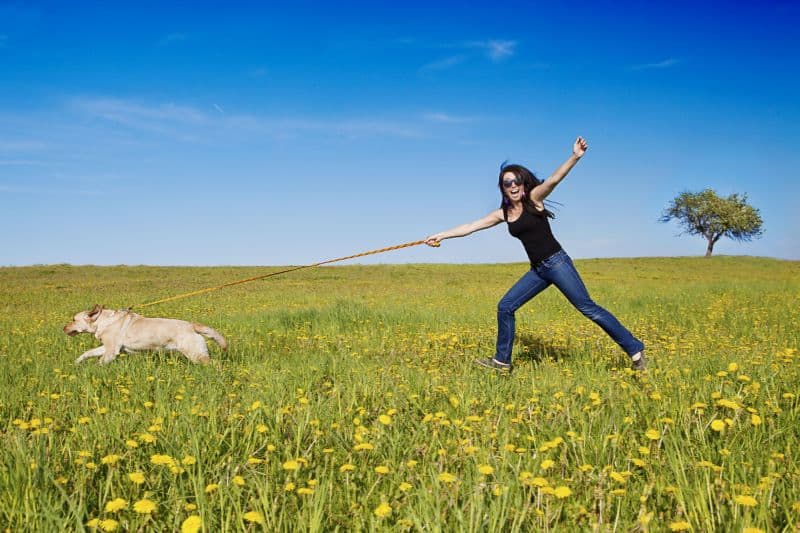
Why Is It Important to Hold Your Dog’s Leash in a Specific Way?
So, now that you know how to hold onto your dog’s leash in the safest way for you and your canine counterpart, you may be wondering, why bother?
Here are some common issues that you can experience when holding your dog’s leash incorrectly:
- You may lose your grip on the leash and drop it, and loose dogs aren’t fun or safe.
- Your dog may yank hard enough on the leash to pull you over (and, with your arm pulled toward your dog, you may not be able to use it to stop your fall); break bones in your fingers, wrist, or arm; or damage cartilage, ligaments, or tendons in your arm, wrist, or hand.
- You may lose control of your dog but still be attached to them, which could put both of you in embarrassing or dangerous situations.
So, just be sure to use one of the three grips discussed above. This will help keep you and your doggo safe during walks.
Special Circumstances for Leash Holding
Although the grips and principles discussed above are applicable to most dogs and their owners, there are at least two sets of special circumstances in which you may need to think about some additional factors.
We’ll discuss both below.
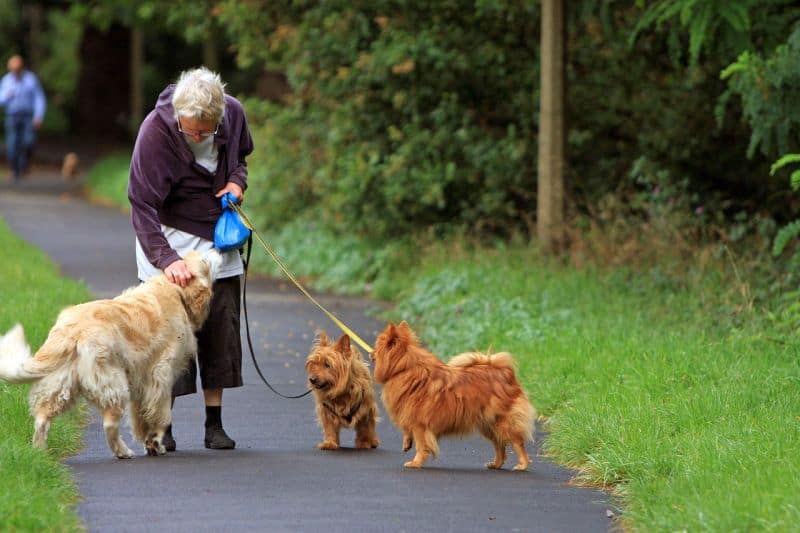
Seniors Walking Dogs
As you may expect, and as explained by researcher Kevin Pirruccio and his colleagues in a 2019 letter to JAMA Surgery, older dog owners are at great risk of being injured if their dog pulls them over.
But, by using one of the leash holding techniques discussed above, you should be able to release your dog’s leash rapidly enough to avoid injury.
If you’re not worried about falling over, hands-free leashes (which are worn around the waist) can help give senior dog walkers more security and control when they walk their dogs. There are also leashes better suited for arthritis that can be a bit easier on the hands.
Owners Walking Reactive Dogs
Another group of dogs who may need extra help with control during walks are those with leash reactive dogs.
This means that they get excited or scared by the presence of certain triggers in their environment (such as other dogs, people walking or running by, cars, bikes, etc.) and they explode in a frenzy. They may bark, jump, pull strongly, or lunge as a part of this display.
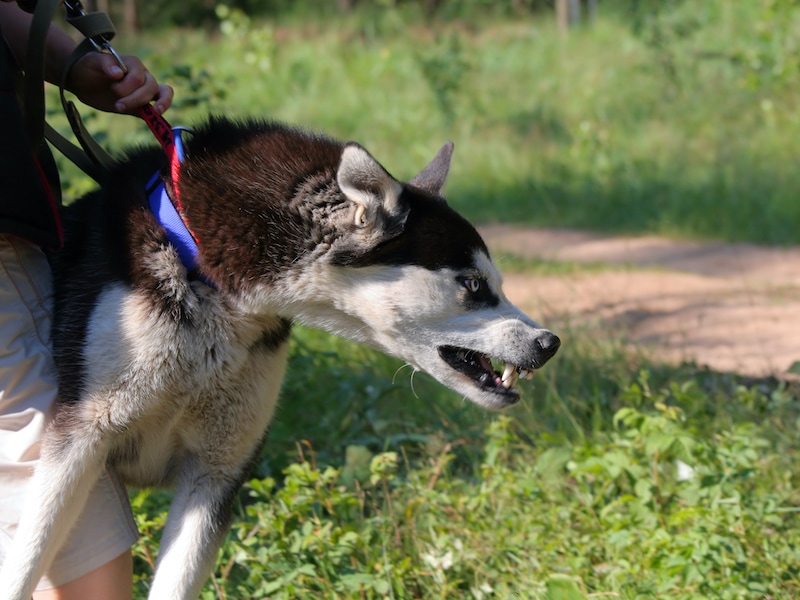
If your dog is leash reactive and you aren’t sure how to remedy the situation, talk to a behavior consultant or work with a professional force-free dog trainer. You can also learn a lot about leash reactivity and get some ideas from our leash reactivity guide.
Your dog may never want to be best friends with the things that upset her, but she can be taught how to act calmly in the presence of her triggers, so you both can enjoy your walks together more.
Using walking equipment like a front-attach, no-pull harness or head collar instead of a regular flat collar or shoulder-attach harness can help get more control into the hands of people whose dogs should not, for safety reasons, pull them at all.
Make sure you understand how to fit these types of harnesses properly before your first walk, and train your dog how to wear a headcollar before using it for walks.
Selecting the Best Leash: Tips from a Trainer
So, now that you’re armed with the knowledge of how to successfully handle your leash, all you need is — your leash! There are so many types, it can be hard to know which one is right for you and your dog.
We’ll go over some categories and styles available below, and suggest some particular types for special situations.

Picking the Right Style of Dog Leash
There are a number of different types of leashes on the market, and owners are often confused about which style is best. We’ll explain two of the most common styles and point out their best applications below.
Standard or Training Leashes
Standard or training dog leashes are generally the best option for most owners and their dogs. These types of leashes are pretty straightforward: They usually consist of a loop at one end, a length of nylon or rope, and a clip at the opposite end.
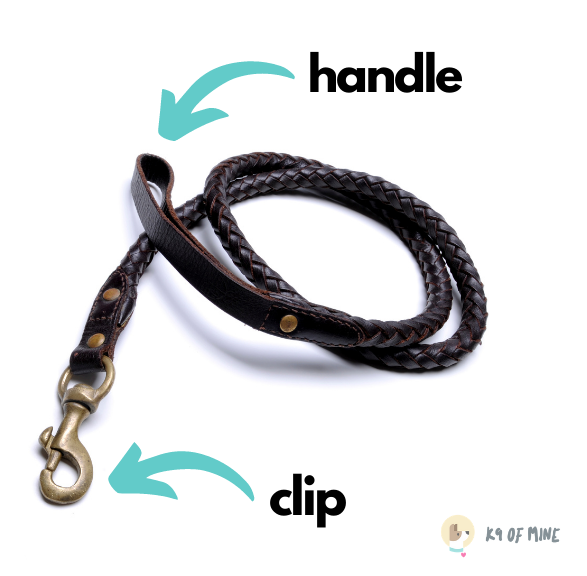
Standard dog leashes provide great control of your dog, and they don’t feature any unnecessary doodads or components to complicate matters.
They’re usually inexpensive, and they are easy to learn how to use too. Best of all, they usually work well with the grips described above.
However, you’ll still want to consider a few key features when picking out a standard dog leash:
- Select a leash that is well made and features high-quality stitching. All leashes will eventually begin to show wear and the threads will begin to unravel, but well-made leashes will hold up for years. Additionally, you don’t want to be using a leash when the stitching snaps, as this will cause an obvious safety issue.
- Look for a leash with reflective stitching, graphics, or materials. Most owners will find it necessary to walk the dog after dark, which presents an obvious safety issue. But reflective leash components will help keep you and your pooch visible to passing motorists.
- Think about the handle of the leash. Some leashes feature padded handles, which can make a leash more comfortable to hold. However, not all owners want or need this type of padding — just think about the issue, try out a few different leashes if you can, and pick the one you think will work best.
- Stick to leashes with secure clasps. Leashes use a variety of different types of connectors to clip to your dog’s collar or harness. For example, some use “lobster claw” connectors, while others use carabiner-style clips. No style is perfect for all situations, but you must select one that features a clip that is easy for you to attach and detach and remains securely clipped during use.
Retractable Dog Leashes
Retractable dog leashes are another leash style, and they are quite popular, since they combine a plastic handle with the option to change the length of the dog’s leash instantly. Some of them are up to 30 feet long!
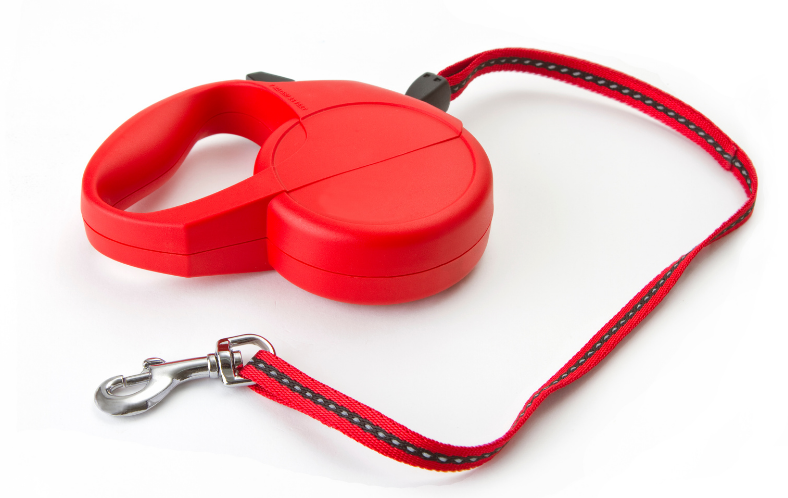
However, these types of leashes are not good for dogs who are learning not to pull on their leash, since most handlers leave the gears inside the handle unlocked as they walk so the leash constantly retracts any slack in the leash.
This causes the dog to have to constantly pull on the leash as they move forward or toward objects they want to explore.
Thus, if the handler ever does want to limit the length of the leash and locks the leash’s brake, the dog will often continue to pull strongly in an attempt to keep moving.
These leashes also allow dogs to range far from their caretakers, which could allow them to find a situation where they get into trouble – the dog may be so far away that the person walking her might not know she’s in danger until it’s too late!
Also, retractable leashes can be dangerous. These leashes all come with instructions that warn people about the possibility of rope burn or amputation for the dog or handler when using the leash, or the possibility that the leash or collar may break and the leash may snap rapidly back toward the handler, which could hit them and cause injury.
Because of the large plastic handle, you cannot use any of the preferred leash holding methods with a retractable leash.
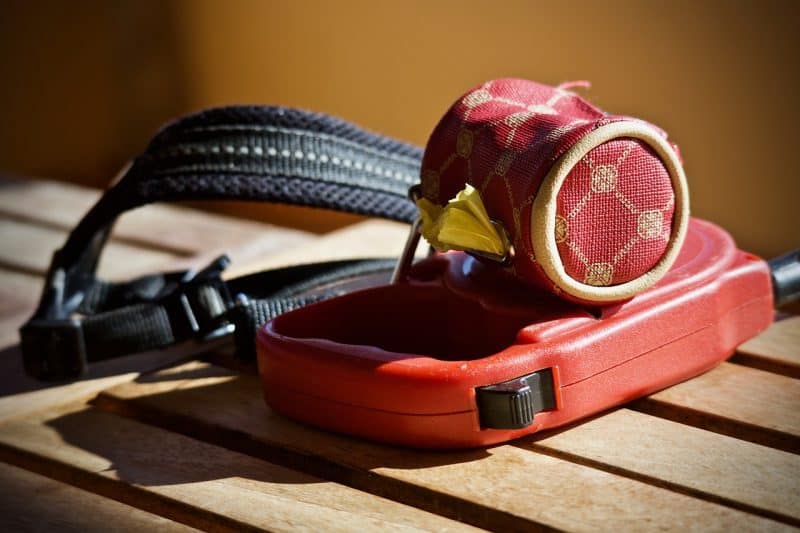
Additionally, if your dog pulls this type of leash out of your hand it will move rapidly towards your dog as it retracts, which could injure them, or terrify them so much that they run away in a panic.
If you do decide to purchase this type of leash, make sure you know your dog’s weight and get a leash rated to hold a dog of that size.
Getting a leash that is too strong for a small dog could prevent the dog from being able to move forward; conversely, getting one that is too small for a big dog will probably cause the leash to break during use.
Also, be sure to use a small-size dog harness if you’re going to use a retractable leash with a small pooch. If retractable leashes are attached to standard flat collars, the pressure of the leash on the dog’s throat could damage the trachea.
Dogs who have already been taught good leash manners and owners who are aware of the risks involved with their use are good candidates for using retractable leashes.
Picking the Best Dog Leash Material
One of the most obvious ways leashes differ is the materials from which they’re made. We’ll discuss some of the pros and cons of different dog leash materials below.
Nylon Dog Leashes
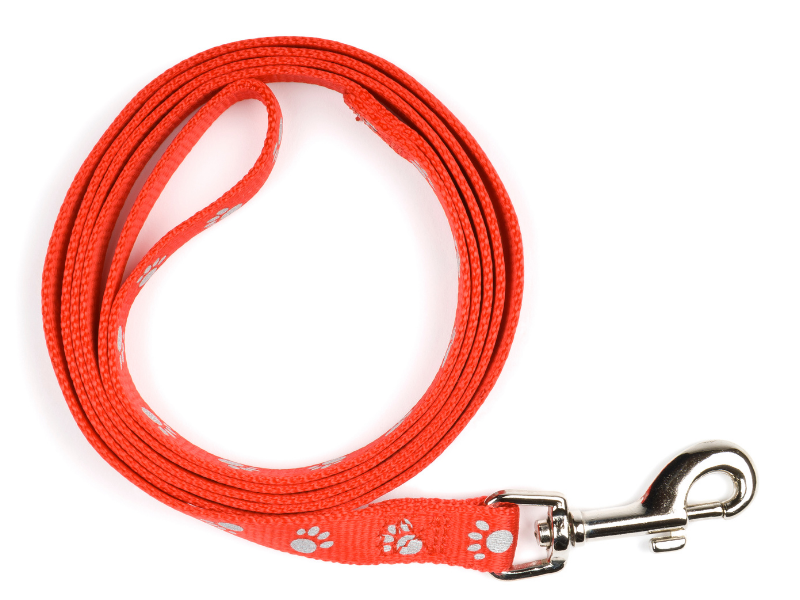
Leashes made of nylon are relatively inexpensive and can vary widely in shape, size, structure and length, but most of them are strong and weather-resistant.
Pick a leash that will be easy for you to hold while using your preferred leash grip – sometimes they’re too thick to grasp a few layers of it in your fist comfortably, or too thin, which can be unpleasant to hold if the dog pulls on the leash.
Many people like the flat nylon leashes best, and oftentimes a 1- or ⅝-inch leash fits in the hand best.
Cotton Dog Leashes
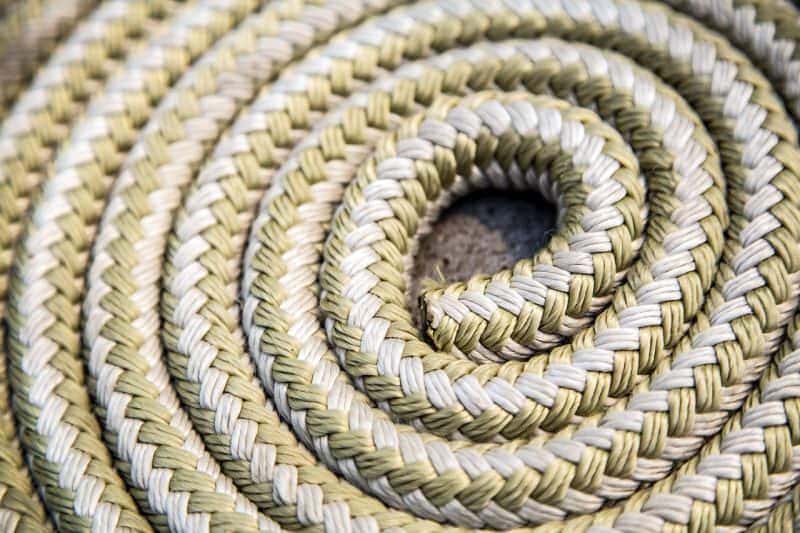
Rope leashes made of cotton are light, flexible, and soft on the hands. They’re available in a variety of colors, styles, and lengths, and many owners prefer them over those made of nylon.
However, rope leashes are also very absorbent, so it’s easy for them to absorb water (and urine!), which can make them heavy by the end of a walk through puddles or dewy grass.
They are also not always chew-proof (especially for big, power-chewing pooches), so they may not be the best choice for dogs who have issues chewing on things.
But, if you like the way rope leashes feel in your hand and have a well-mannered pooch, who does not have chewing problems, you may want to consider a rope leash.
Chain or Cable Dog Leashes
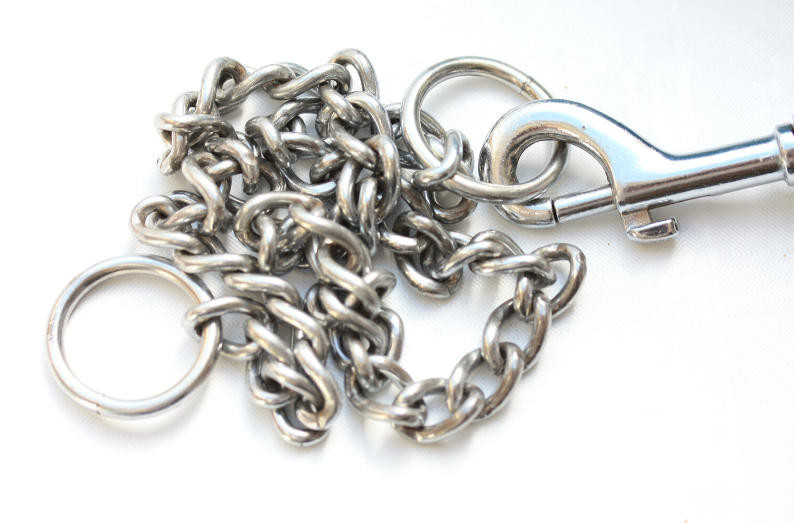
Chain or cable leashes are excellent for dogs who may bite their leashes since they are extremely chew-resistant leashes. They may be helpful as an owner works on teaching their dog not to chew or bite on the leash.
They are made of metal so they weigh more than other leash types, and often have a handle made of leather or nylon to make them more comfortable for the handler to hold.
These tend to rust if left outside, but they are usually very strong and last a long time.
Cable leashes are not common, and are a bit more expensive than some other leash types. They aren’t very flexible, so carrying them may not be as comfortable.
Shorter cable leashes are also excellent for using as tie downs in the home.
Leather Dog Leashes
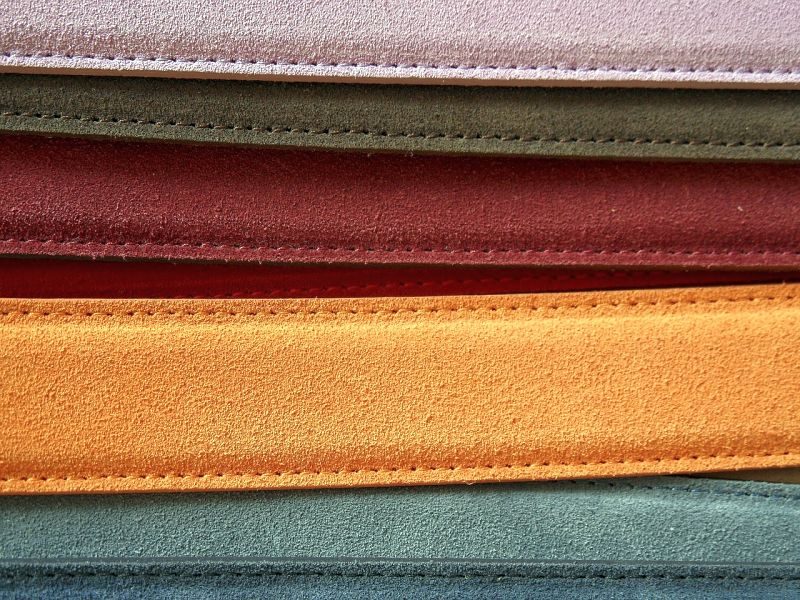
Many dog handlers like leather leashes since they come in a variety of lengths and thicknesses; they are strong and lightweight; and they feel better in the hand than either chain or nylon leashes do.
However, since they can be damaged by a dog biting or chewing them and they tend to be a bit expensive, they are not a favorite for walking dogs who still chomp and chew on their leash.
Leather leashes can also be difficult to clean thoroughly, and they are sensitive to the weather. You’ll need to store leather leashes indoors, away from the sun and rain.
Rubber Dog Leashes
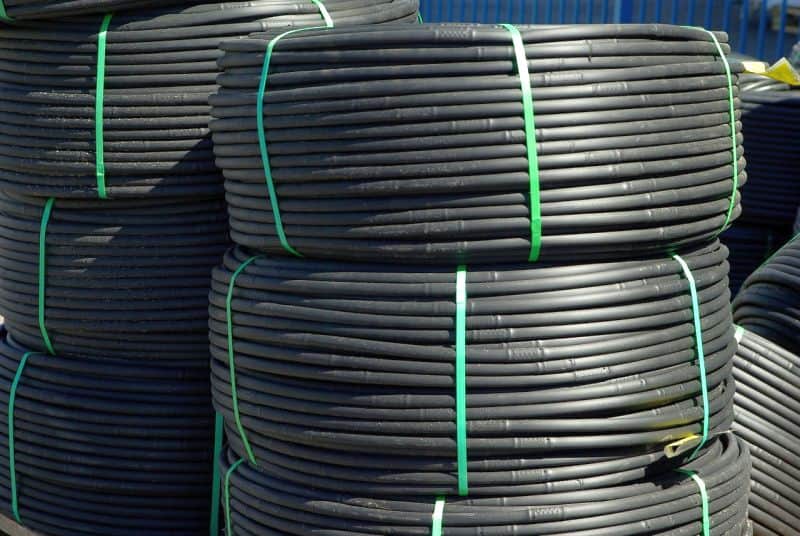
Some leashes available are made of rubber, or feature a section of rubbery or elastic material. These leashes are supposed to ease the pressure of the leash on the dog and the handler when the dog pulls suddenly.
These types of leashes are not a bad idea, but they don’t really do much to help with a strong pulling dog, and the rubber is much less durable than other leash materials.
If you do decide to get a leash of this type, make sure there is another material, like nylon, which makes up the length of the leash as well, so there’s a backup in place if the leash breaks during use.
Choosing the Right Dog Leash Length
Most dogs do best with a leash that allows them to enjoy their walk and smell the roses without causing a hazard to themselves or others.
6 Foot Leash is Usually Standard
Many people like to use a standard 6- or 4-foot leash, but keep in mind the height of the person and dog who will be using it.
For instance, a tall person walking a short dog may need a longer leash than the same person walking a taller dog.
However, big dogs usually also have longer bodies, and they seem to appreciate having a leash long enough so they aren’t constantly bumping into their person with their hip.
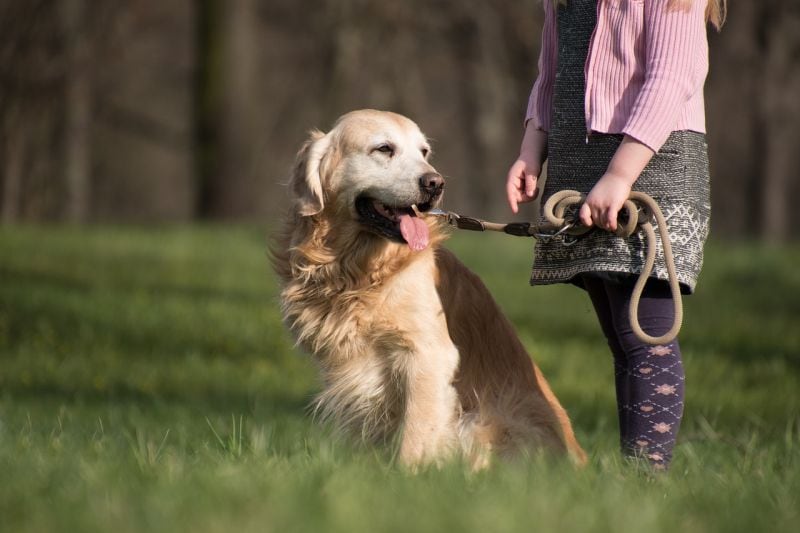
Using a standard length leash of 4’ or 6’ is usually a good idea.
This way, you have enough leash length to allow your dog to explore the edges of your path a bit without having to deal with lots of extra slack, or giving them so much slack that they wrap around trees (or other people!).
Consider a Long Lead For Outdoor Training
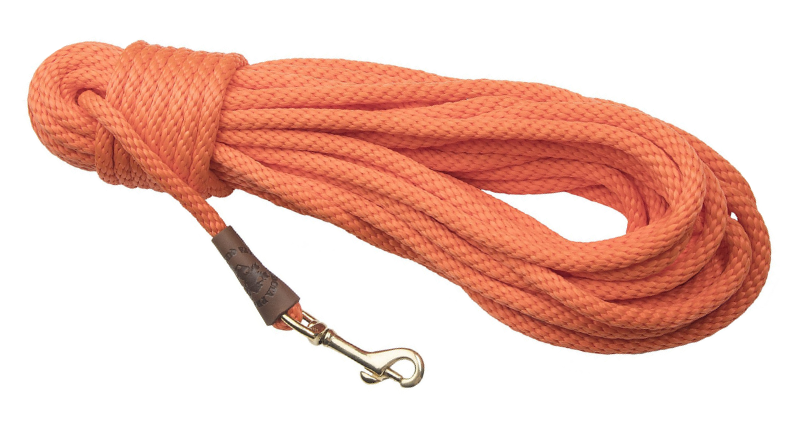
When training your dog, one of the variables that can be adjusted and practiced that can improve a dog’s overall consistency is distance.
The best way to safely practice cues while working on adding distance is by attaching a long lead (aka long leash) to your dog so if they get distracted you still have physical control of them.
Long leashes are also a great way to give a dog more space to run around while walking her, and they are fun to use in large, open spaces.
However, because the dog has so much more distance to run and pick up speed, they can pull much harder on a long leash than a shorter one.
Also, dogs on a long leash can wrap the leash around objects and people near them, which could damage the leash, the objects, and the people!
Training With Tabs
Another type of training leash is called a “tab,” and is basically a very short dog leash, usually less than 12”.

Tabs are often used by trainers who have worked with a dog for a while and are attempting to transition to off-leash behaviors.
The tab can be used to safely maneuver the dog through crowded situations or on a supervised dog as a quick-grab handle, and is often easier and safer than grabbing a dog’s collar.
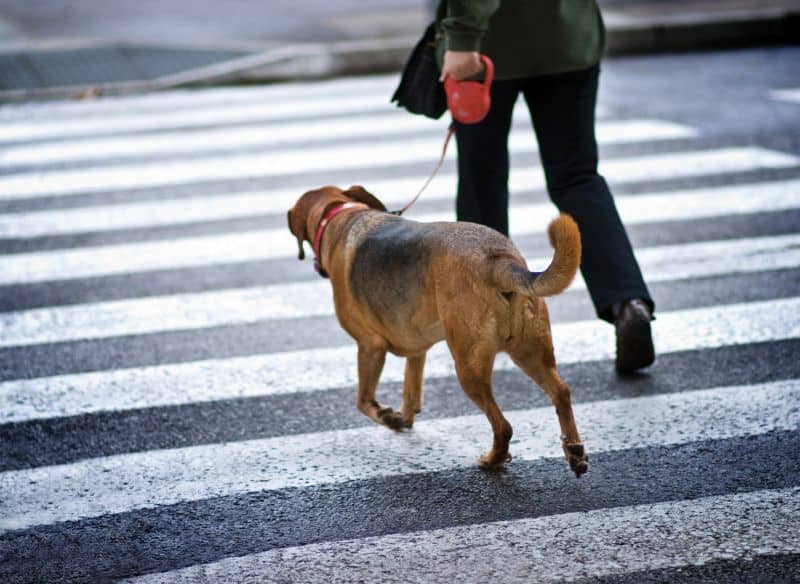
Dog Leash Hand Position FAQs
Even though leash-holding is a fairly simple subject, it generates a lot of questions among owners. We’ll try to answer some of the most common leash-holding questions below.
Should dogs always be leashed during walks?
For safety reasons, all dogs should be taught good leash manners and remain leashed while walking in public.
While there are off-leash dog parks available to some owners, you have to get to the park somehow. Also, no matter how well-trained a dog is, the possibility of accidents goes up when there is no physical object keeping a dog safely near their people. Off-leash accidents are such a shame, because they are often preventable.
Is it bad for dogs to pull on a leash?
Not only is it uncomfortable for the dog and the person walking her, but a dog that pulls on her leash can also cause damage to her throat or injure the person walking her.
Furthermore, a tight leash can cause dogs to feel more tense during their walk, which can contribute to behavior issues like leash reactivity. Teaching your dog to walk on a loose leash isn’t particularly difficult — you just have to be willing to put in some time and effort.
Should you drag your dog if she doesn’t want to walk on a leash?
When a dog won’t walk or stops and lays down during a walk, dragging her is not a good solution, and it may cause her to suffer an injury.
It’s possible that she may have something wrong with her, and that’s why she might suddenly pancake in the middle of an outing.
Keep in mind, no dogs are born knowing how to walk on a leash, so if your dog is young or inexperienced with wearing a collar and leash, patience and training are important to teach her how to get used to and enjoy her time on a leash with you.
***
Walking our dogs is an excellent way to share some joy with them! Utilizing the leash skills you just learned can help you continue to enjoy your outings with your pooch safely and happily.
Have you and your dog experienced difficulty because of leash handling issues? What is your favorite way to hold a leash and why?
Share your experiences (and any questions you may have) in the comments below!
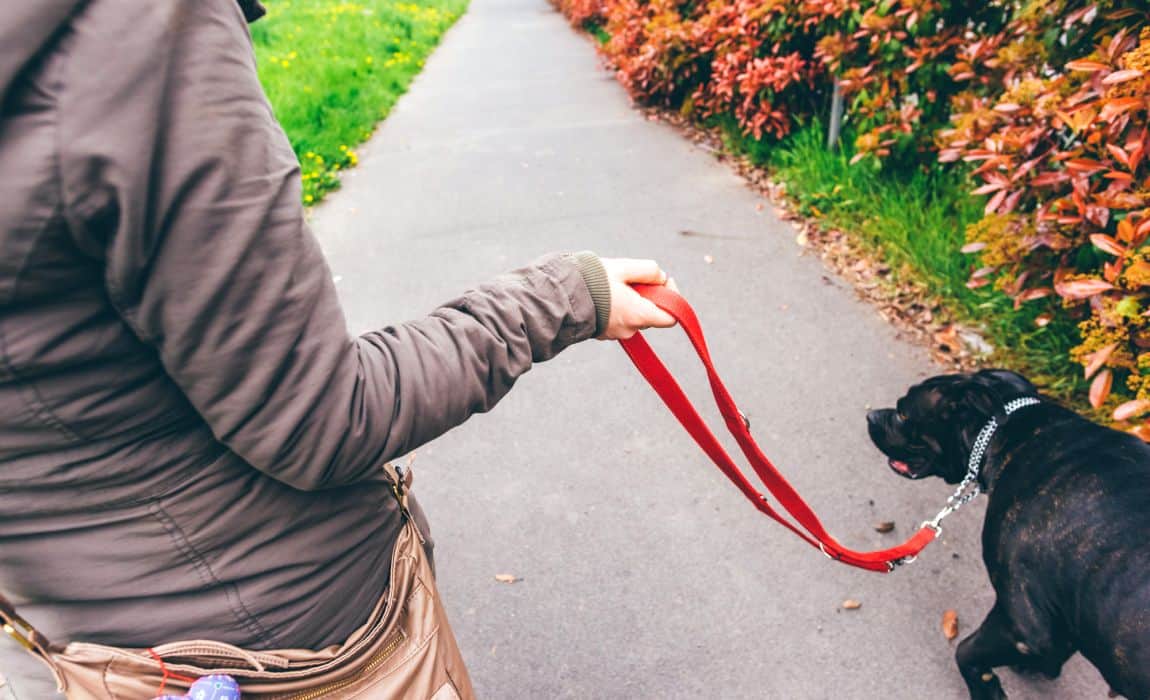
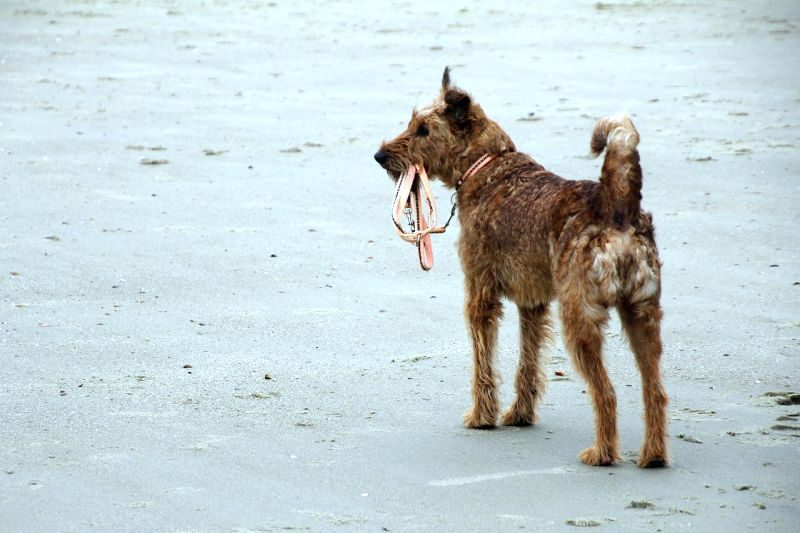

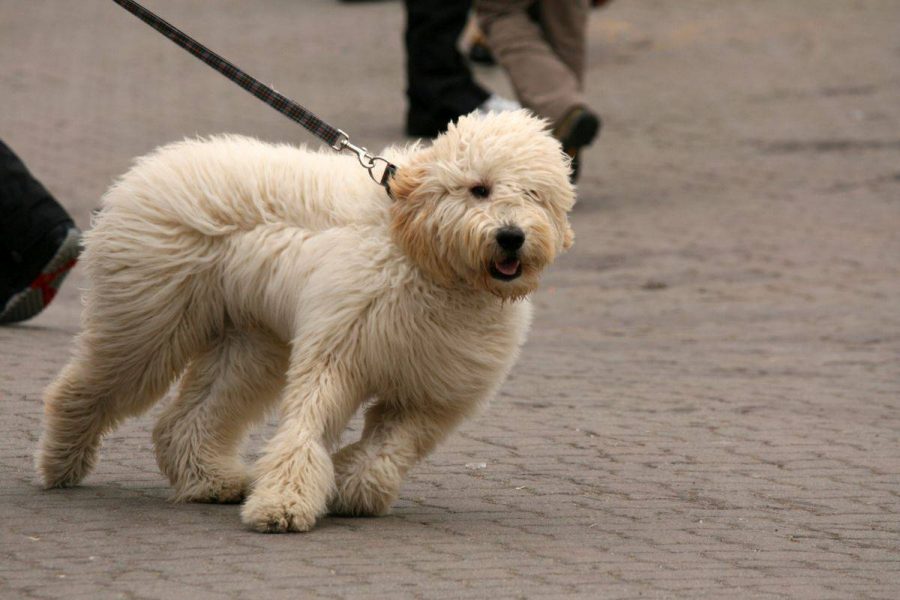


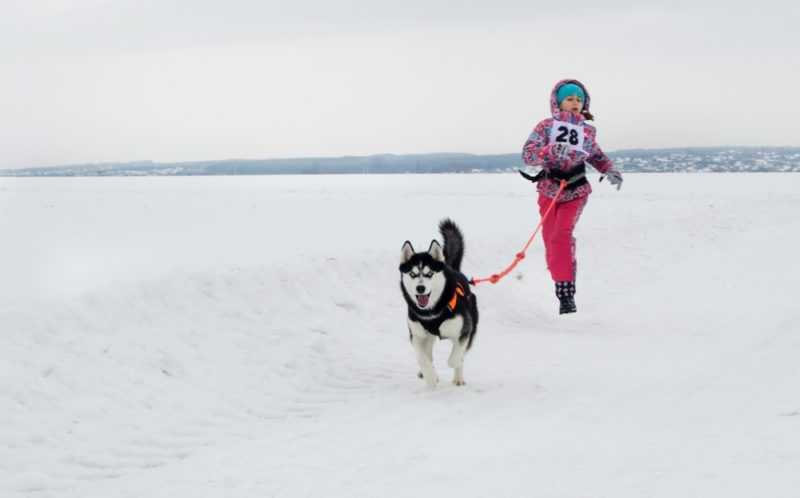
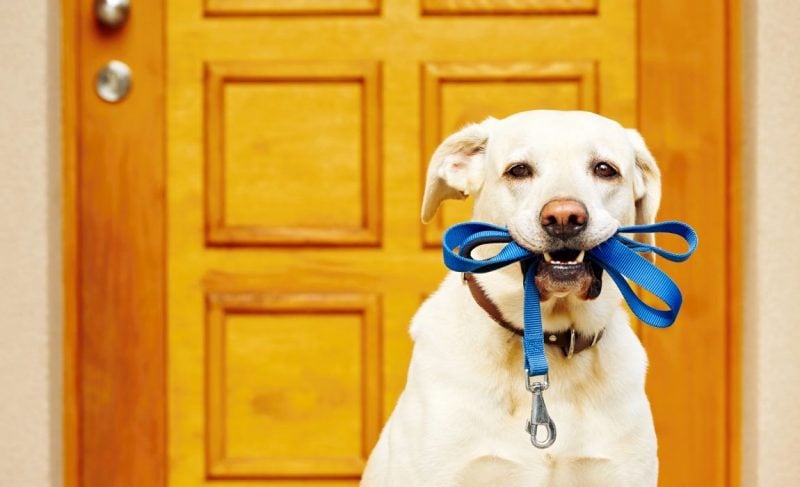
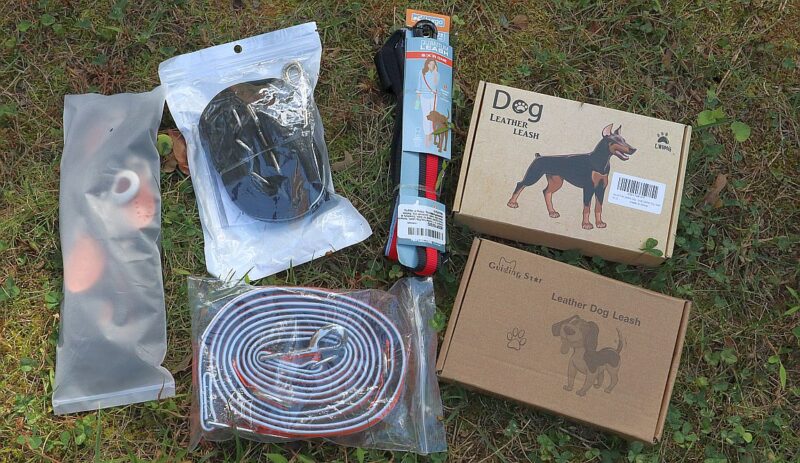
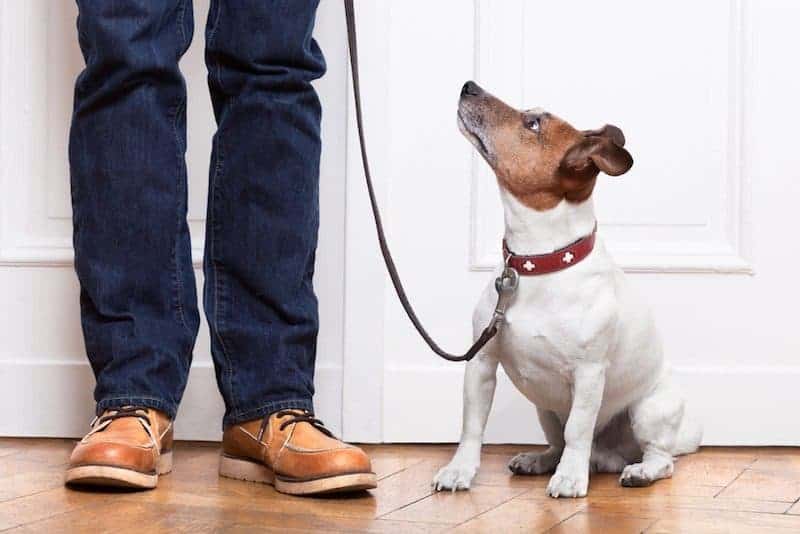
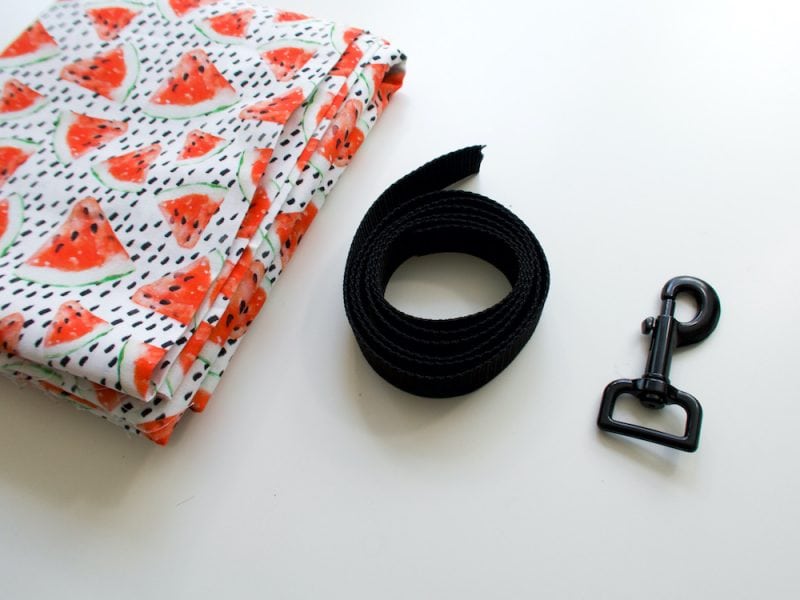

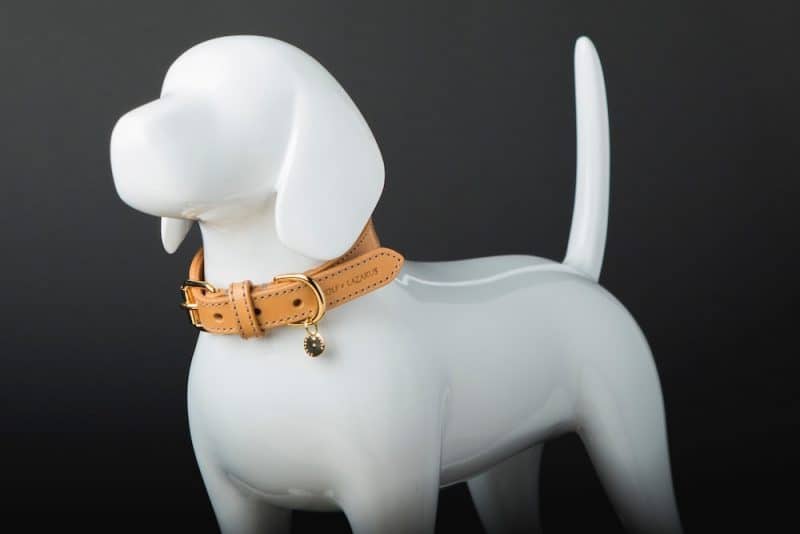

Leave a Comment